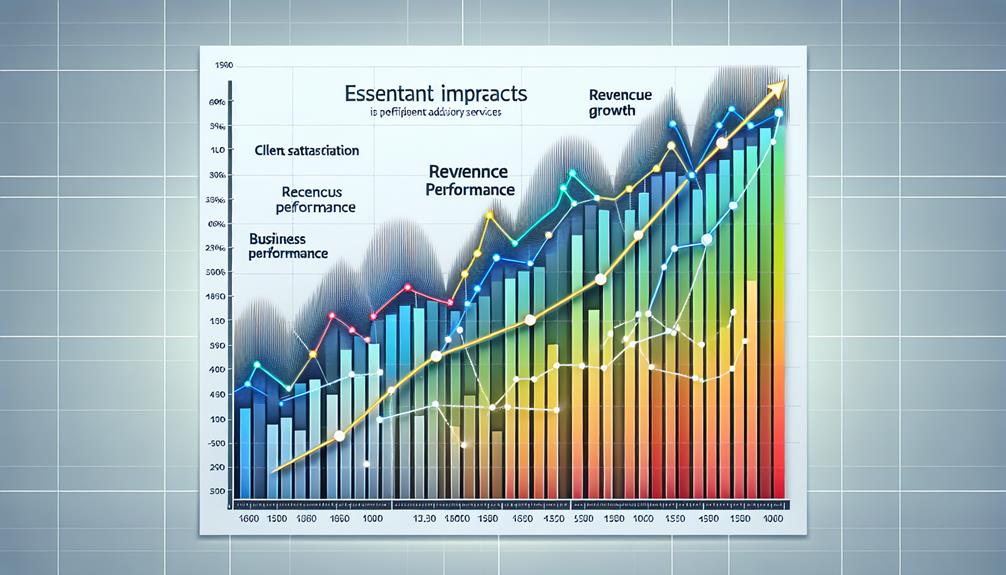Are you a business advisor looking to enhance your success? One essential aspect to consider is measuring the right metrics. Take, for example, revenue growth. It is a key indicator of how well your advisory services are helping clients achieve their financial goals. But revenue growth alone is not enough. There are other crucial metrics to consider, such as client retention, profitability analysis, customer satisfaction, and advisory impact. These metrics provide valuable insights into the effectiveness of your advisory efforts and can help you drive better outcomes for your clients. But what exactly do these metrics entail, and how can they contribute to your overall success? Let's explore further.
Revenue Growth

To achieve business advisory success, it is essential to focus on increasing your revenue growth. Revenue growth is a key metric that indicates the financial health and sustainability of your business. By effectively managing and improving your revenue growth, you can ensure the long-term success and profitability of your business.
One way to increase revenue growth is by attracting new customers. Acquiring new customers expands your customer base and opens up new opportunities for sales and revenue. Implementing targeted marketing strategies, improving your online presence, and providing exceptional customer service are all effective ways to attract new customers and drive revenue growth.
Another strategy to boost revenue growth is by increasing the average transaction value. Encouraging customers to purchase additional products or services, upselling or cross-selling, and offering product bundles or packages can all contribute to higher transaction values and increased revenue.
Additionally, focusing on customer retention is crucial for sustained revenue growth. Building strong relationships with your existing customers, delivering value-added services, and providing exceptional customer experiences can help foster loyalty and repeat business, leading to increased revenue over time.
Client Retention
In order to achieve long-term success and sustain revenue growth, it is crucial to prioritize client retention. Building strong relationships with your clients and keeping them satisfied is essential for the growth and stability of your business. By focusing on client retention, you can not only increase customer loyalty but also reduce customer churn and the costs associated with acquiring new clients.
One of the key metrics to measure client retention is the customer retention rate (CRR). This metric helps you understand the percentage of clients that continue to do business with you over a given period of time. By tracking this rate, you can identify any decline in client retention and take proactive steps to address any issues that may be causing it.
Another important metric is the net promoter score (NPS). This metric measures the likelihood of your clients recommending your business to others. A high NPS indicates satisfied and loyal clients, while a low score suggests areas for improvement.
To improve client retention, it is crucial to provide exceptional customer service, deliver on your promises, and regularly communicate with your clients to understand their needs and expectations. By investing in client retention strategies, you can foster long-term relationships, enhance customer loyalty, and ultimately drive sustainable revenue growth for your business.
Profitability Analysis

By analyzing your business's profitability, you can gain insights into the financial health of your company and make informed decisions to drive long-term success. Profitability analysis allows you to assess your business's ability to generate profits and determine the effectiveness of your strategies and operations. It involves examining various financial metrics and ratios to understand how efficiently your business is utilizing its resources and generating returns. One key metric to consider is gross profit margin, which measures the profitability of your products or services after deducting the direct costs of production. A high gross profit margin indicates that your business is effectively managing its costs and generating healthy profits. Another important metric is net profit margin, which measures the profitability of your business after deducting all expenses, including overhead costs. By analyzing this metric, you can assess your business's overall profitability and evaluate its ability to generate returns for its owners. Additionally, analyzing profitability by customer segment or product line can help you identify which areas of your business are the most profitable and allocate resources accordingly. By regularly analyzing your business's profitability, you can identify opportunities for improvement, optimize your operations, and make informed decisions to drive long-term success.
Customer Satisfaction
Your customers' satisfaction with your products or services is crucial to the success of your business. Happy customers are more likely to become repeat customers and recommend your business to others. Therefore, it is important to measure and continuously monitor customer satisfaction to ensure that you are meeting their needs and expectations.
One way to gauge customer satisfaction is through surveys or feedback forms. By asking customers about their experience with your business, you can gather valuable insights on what is working well and what areas need improvement. These surveys can be conducted through various channels such as email, social media, or in-person interactions.
Another metric to consider is the Net Promoter Score (NPS), which measures the likelihood of customers recommending your business to others. This can provide an indication of how satisfied your customers are and how likely they are to spread positive word-of-mouth about your business.
In addition to surveys and NPS, it is also important to analyze customer complaints and feedback. By addressing and resolving any issues promptly, you can not only improve customer satisfaction but also build trust and loyalty.
Advisory Impact

To measure the impact of your business advisory services, evaluate the tangible outcomes and improvements achieved by your clients. This is an essential metric that allows you to understand the effectiveness of your guidance and the value you bring to their businesses. By assessing the results your clients have achieved, you can determine whether your advisory services are making a significant impact.
One way to evaluate advisory impact is by looking at the financial performance of your clients. Have they experienced an increase in revenue or profit margins? Are they able to generate more cash flow or reduce costs? These are measurable outcomes that directly reflect the effectiveness of your advice.
Another aspect to consider is the operational efficiency of your clients. Have they streamlined their processes and improved productivity? Are they able to meet customer demands more effectively? These improvements demonstrate the positive impact of your advisory services on their day-to-day operations.
Additionally, consider the strategic decisions made by your clients. Have they successfully implemented new business strategies or entered new markets? Are they able to adapt to changes in the industry and stay competitive? These strategic advancements highlight the value of your guidance in helping them achieve their long-term goals.

